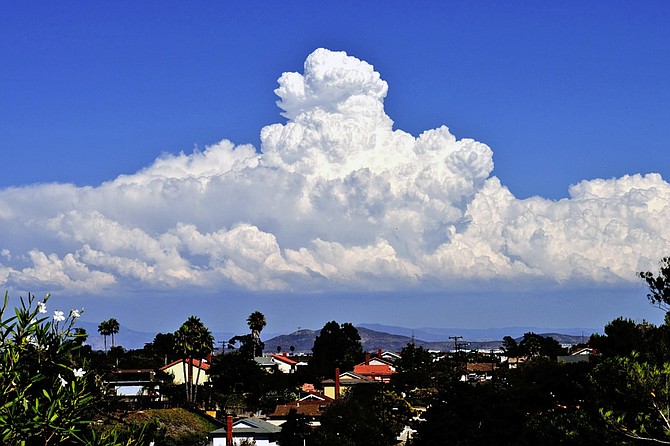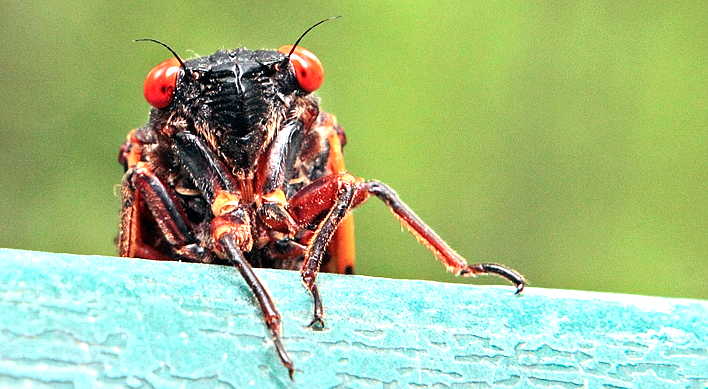 Facebook
Facebook
 X
X
 Instagram
Instagram
 TikTok
TikTok
 Youtube
Youtube

Cumulonimbus Clouds, or thunderheads, are most likely to form over San Diego County’s deserts and mountains during the latter part of the summer season, beginning about mid-July. The clouds appear by midafternoon — often the result of moist, tropical air entering the county from the south or southeast. If intense, these cloud buildups are accompanied by enough rain to flood the desert washes and mountain drainages. When the weather pattern allows the movement of moist air beyond the mountain barriers, even coastal San Diego County can experience the cool spatter of raindrops and spectacular evening lightning displays.

Elderberry, a common bush or small tree found from San Diego County’s coastal canyons to the mountain slopes around Julian and Palomar, is in fruit this month. The branches carry myriads of tiny bluish fruits covered with a white powder. The fruits have traditionally been used for various drinks and preserves.

Cicadas, the insects that sound like tinny buzzsaws in the brush, have been putting up a racket around San Diego lately. Occasionally mistaken for the tail buzz of a rattlesnake, the sound is merely that of a male calling to potential mates. Some 30 species of cicadas inhabit San Diego County, but none are of the famous periodical type that emerge en masse every 13 or 17 years to serenade parts of the eastern United States.
The tides are peaking July 13-14 with a high of 7.65 ft at 9:30 pm on July 13 and a peak low of -1.86 ft at 4:45 am on July 14.
July’s full Buck Moon orbits closer to Earth than any other full Moon this year, resulting in the biggest and brightest supermoon of 2022. At its nearest point, the Buck Moon will be 222,089.3 miles (357,418 km) from Earth, 200km closer than June’s Strawberry Moon. July’s full moon is called the Buck Moon because the antlers of male deer (bucks) are at peak growth in July. Bucks shed and regrow their antlers each year, getting larger as the years go by.
The above comes from the Outdoors listings in the Reader compiled by Jerry Schad, author of Afoot & Afield in San Diego County. Schad died in 2011. Planet information from SkyandTelescope.org.


Cumulonimbus Clouds, or thunderheads, are most likely to form over San Diego County’s deserts and mountains during the latter part of the summer season, beginning about mid-July. The clouds appear by midafternoon — often the result of moist, tropical air entering the county from the south or southeast. If intense, these cloud buildups are accompanied by enough rain to flood the desert washes and mountain drainages. When the weather pattern allows the movement of moist air beyond the mountain barriers, even coastal San Diego County can experience the cool spatter of raindrops and spectacular evening lightning displays.

Elderberry, a common bush or small tree found from San Diego County’s coastal canyons to the mountain slopes around Julian and Palomar, is in fruit this month. The branches carry myriads of tiny bluish fruits covered with a white powder. The fruits have traditionally been used for various drinks and preserves.

Cicadas, the insects that sound like tinny buzzsaws in the brush, have been putting up a racket around San Diego lately. Occasionally mistaken for the tail buzz of a rattlesnake, the sound is merely that of a male calling to potential mates. Some 30 species of cicadas inhabit San Diego County, but none are of the famous periodical type that emerge en masse every 13 or 17 years to serenade parts of the eastern United States.
The tides are peaking July 13-14 with a high of 7.65 ft at 9:30 pm on July 13 and a peak low of -1.86 ft at 4:45 am on July 14.
July’s full Buck Moon orbits closer to Earth than any other full Moon this year, resulting in the biggest and brightest supermoon of 2022. At its nearest point, the Buck Moon will be 222,089.3 miles (357,418 km) from Earth, 200km closer than June’s Strawberry Moon. July’s full moon is called the Buck Moon because the antlers of male deer (bucks) are at peak growth in July. Bucks shed and regrow their antlers each year, getting larger as the years go by.
The above comes from the Outdoors listings in the Reader compiled by Jerry Schad, author of Afoot & Afield in San Diego County. Schad died in 2011. Planet information from SkyandTelescope.org.
Comments